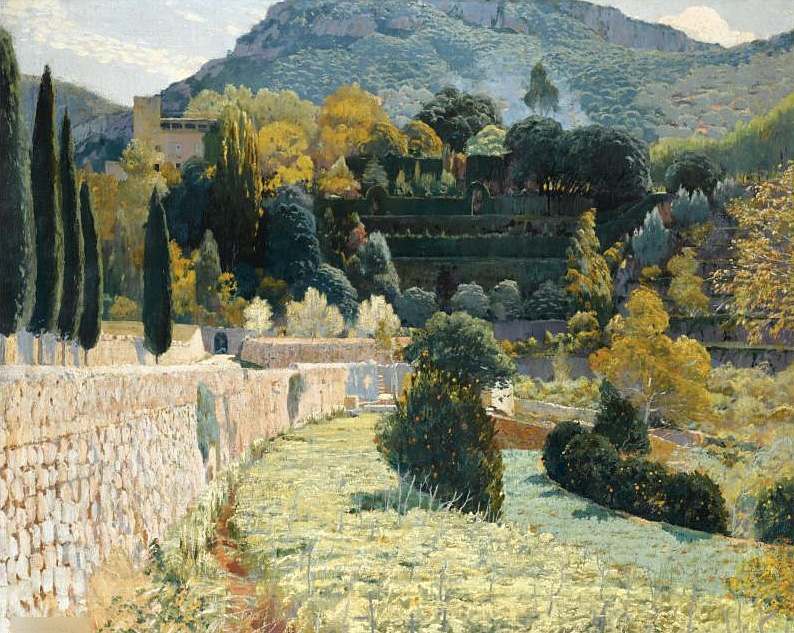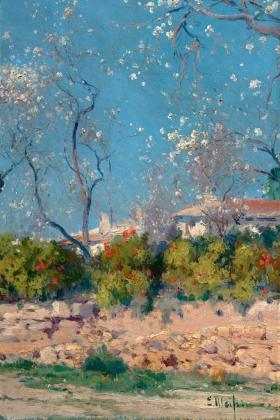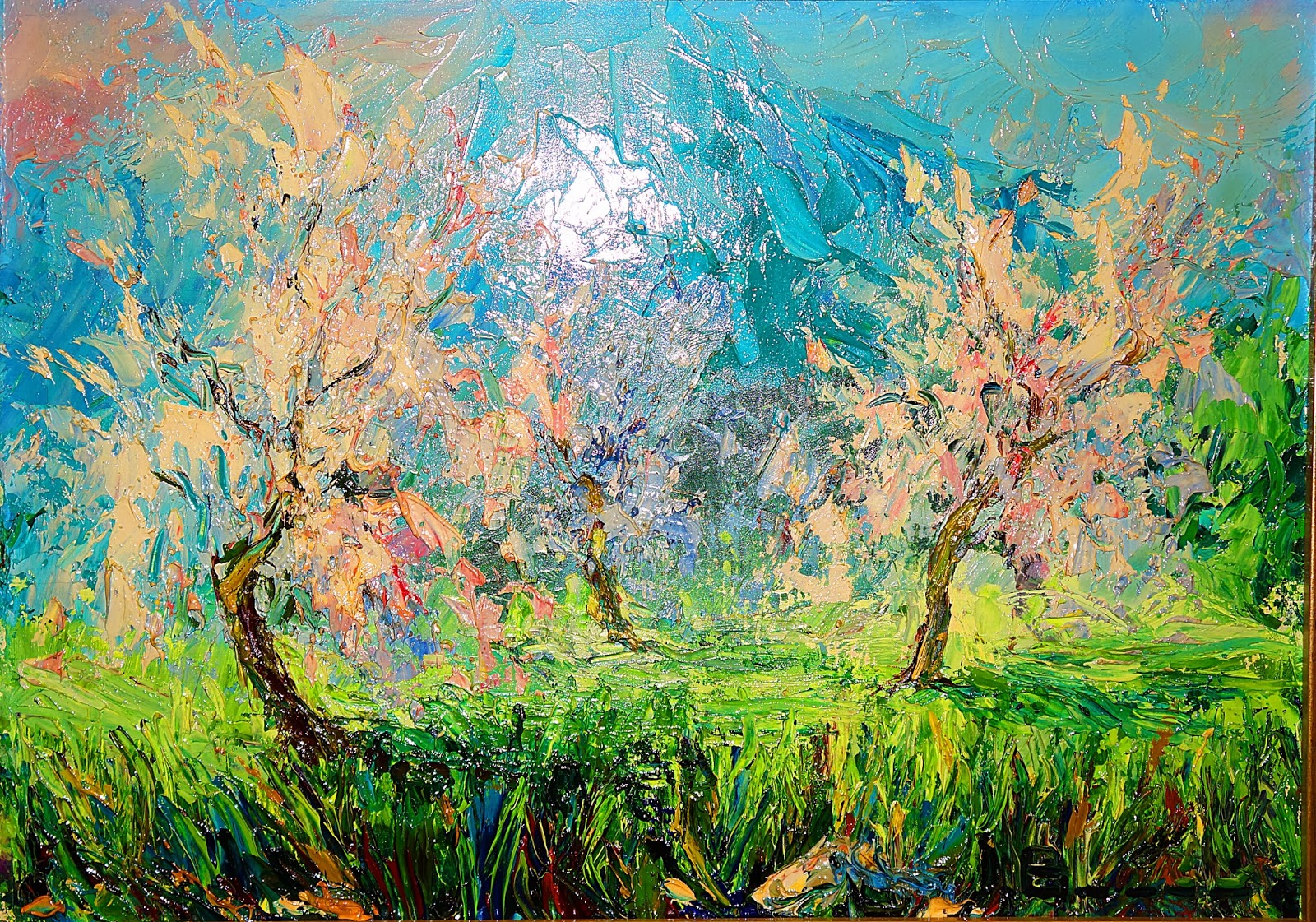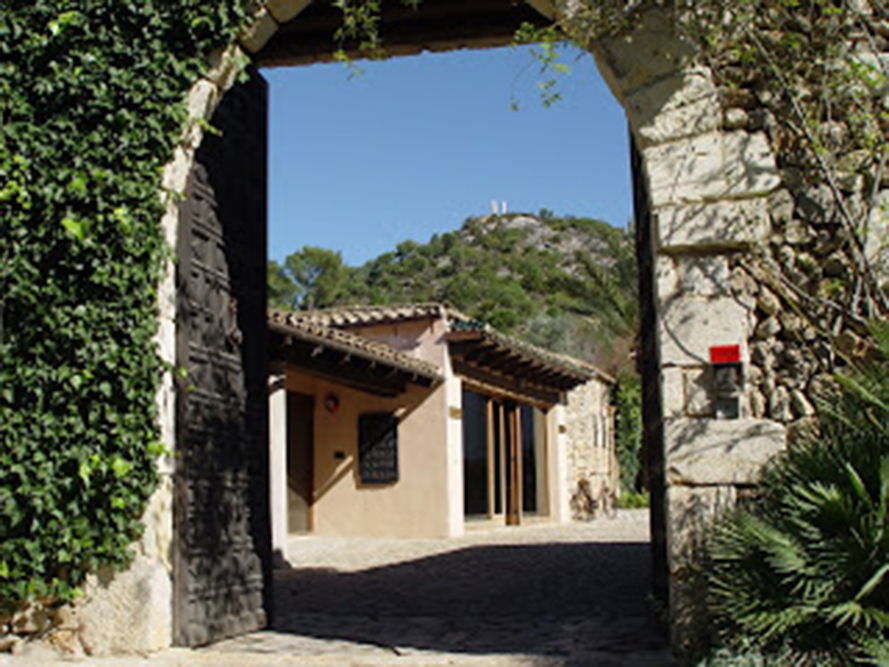A wall display of Mallorcan painted roof tiles took me on a journey of delight and fascination, a gift from earlier times when home owners believed in protection against many misfortunes.
Read MoreMallorca
The Alchemy of Art /
A visit to an unusually simple and beautiful new hotel in Mallorca reminds me how art is indeed alchemy.
Read MoreCelebrating Ikat, Mallorcan Style /
A quest for face masks led me to a wonderful family fabric maker of Mallorcan ikat or Llengües materials. It because a visual feast and fascination.
Read MoreLandscapes /
The snow had fallen all night, but the morning dawned clear and sharp. To the south, as I topped the first rise of the hills, lay the Pyrenees, higher, more intricate in form and peak, more immense in span of horizon than I remembered. My second time as an artist in residence at Bordeneuve was beginning in beauty. Some of the peaks were blushed pink-apricot, others were subdued in greys and pearls. The foreground of rolling, energy-filled hills was their prelude, dark with winter filigree of trees. This massive display of seemingly timeless mountain ranges, so memorable, so old, so sacred and so wildly beautiful, left me with mixed emotions. I could understand why early man used the Pyrenees mountain caves and dwelt in these abodes close to their food sources and to their gods.
Read MoreAlmond Blossom - a Joy for Artists /
January and February in Mallorca, Spain, are months of delight for those of us who love almond blossom. The island is transformed into fairyland, with row upon row of pink and white blossom undulating through the valleys and over the plains, always with the backdrop of dramatic blue-green mountains and azure winter skies. Beneath the trees lie carpets of emerald winter wheat sprouting or grazing land that is dotted with huge herds of shaggy sheep, often with early fragile lambs. The incredible winter light playing over the blossom is crystalline and renders every detail vivid and gem like.
Almond blossom not only plays an important role in ensuring the production of almonds, always an important crop, and a major tourist attraction in Mallorca; it has also inspired many artists. Perhaps the most famous among these artists were those of the 19th and early 20th century, many of them from Catalonia, who visited the island and were captivated by the island landscapes and. above all, the light here. Even Joaquin Sorolla exclaimed, "This light, this light, it is impossible to capture it!" ("Esa luz, esa luz, es impossible capturarla!").
One of the most famous of the Catalan painters who became one of Mallorca's leading landscape painters was Santiago Rusiñol i Prat. He was also a noted writer, poet and playwright. Born in 1861, he came first to Palma in 1893. After spending time in Paris, he returned to Mallorca in 1901, partly to get over a drug addiction. From then on, he spent a great deal of time on the island, celebrating its scenery, gardens and flowers. In 1912, he also published La Isla de la Calma, a paen to the Island of Calm, Mallorca, that he believed was a bulwark against the increasingly frenetic industrial and materialistic world elsewhere.
Terraced Garden in Mallorca, Santiago Rusiñol, 1904
Santiago Rusiñol was often accompanied by artist friends during his stays in Mallorca. Joaquin Mir (1873-1940) was one of his companions, and lived for four years in Mallorca from 1901 onwards, often in the north of the island around Pollensa.. He became known as the father of Mallorcan impressionism, having evolved from an early much more personal approach to painting, when he merged form and colour. Mir too fell under the spell of the springtime almond blossom around the island.
His early paintings of spring differ greatly from his later work, but all sing of Mallorca's light and extraordinary beauty that comes in January and February.
Another of Santiago Rusiñol's friends in Paris and Barcelona was Eliseu Meifrèn i Roig, (1857-1940), a Catalan who travelled widely and was highly respected for his plein air approach to landscapes. He too came to Mallorca as the new century dawned; ultimately he became director of the Art School in Palma in 1910. His paintings of almond blossom are lyrical.
Eliseo Meifrén taught another Palma-born artist who became very well known for his paintings of Mallorca, Joan Fuster Bonnin (1870-1943). Talented and prolific, he was friendly with Santiago Rusiñol and Mir, and later, with another very successful artist in Mallorca, Anglada Camarasa.
How many paintings can one appreciate of almond blossom? I don't know, but I do know that the late 19th and early 20th century saw an amazing number of artists tackling paintings of these almond trees in flower. Incidentally, these blossoms are rather short-lived, for winter winds and rain play havoc with them, and within the space of a week, the tender brilliantly green pointed little leaves begin to replace the pink or white blooms.
Another four examples of artists who loved Mallorca in January and February. Take your pick!
Perhaps the suitable footnote to all the artists' paintings of Mallorca's almonds and the light in which they sparkle is to add the fact that almonds are the earliest domesticated tree nuts, originating in the Levant and spreading through the Mediterranean basin. It is thought that almond trees were first introduced to Mallorca during the Roman times, after Quinto Cecilio Metelo conquered the Balearic Islands in 123 BC. When grapes were so badly affected by phylloxera towards the end of the 19th century, the Mallorcans planted almonds as a replacement crop. Thus the Catalan and Mallorcan artists had such wonderful panoramas of almond trees in flowers to delight and inspire them.
Another museum worth visiting in Mallorca /
There is another small museum which has recently opened in Mallorca which offers a delightful focus to a visit to the town of Soller, nestled in a grandiose valley beneath towering mountain ranges, to the north of the island. Can Prunera is a small museum of modern art, housed in a refurbished Modernist building built between 1909 and 1911, in the era when Antoni Gaudi's influence was paramount.
Facade of Can Prunera, Soller, Mallorca (Image courtesy of Can Prunera)
Many of the restored details of the house are delightfully typical of that time. Gaudi had indeed been working in Palma, restoring and improving the interior of the Seu, the wonderful Gothic Cathedral overlooking the sea. He had started work there in 1902 but by 1914, he had fallen out with the ecclesiastical authorities and stopped the work. His influence, however, showed up in many Mallorcan Modernist buildings, and especially in Soller.
Can Prunera's staircase (Image courtesy of Can Prunera)
Can Prunera houses part of the art collection of newpapers owner, Pedro Serra, who has been instrumental in the refurbishment and launching of the museum through his Fundacion Tren de l'Art and Fundacion d'Art Serra. His father apparently worked for the Soller-Palma train company for a time, and his son has completed this circle in time.
The day I visited the Museum, only a few rooms were open. Miró acquatints gladdened three galleries, and a collection of Picasso ceramics was exhibited in two other galleries. The connections between Picasso and Miró were underlined by big photo reproductions of the two of them together on different occasions. Apparently, most of the art planned for exhibition will have some connection with Mallorca.
Off the beaten path in Mallorca /
There are plenty of hidden gems in Mallorca that reward the explorer. One of them that had long tantalised me is the Yannick and Ben Jakober Foundation at Sa Bassa Blanca, just outside Puerto de Alcudia, on the eastern coast.
En route to Sa Bassa Blanca, Mallorca (Rundle Cook photographer)
Nestled on long slopes sweeping down to sapphire waters, the buildings and gardens that form the exhibition spaces are an interesting mixture of foreign exoticism and Mallorcan architecture. The house and partial exhibition spaces were built by Egyptian architect, Hassan Fathy, with white crenellated walls and an interior courtyard that harks back to the Alhambra. Latticed windows and elements from Morrocco, Turkey and Andalucia all mingle to form an abode of great character, the backdrop to a collection of art and sculpture that underline Yannick and Ben Jakober's status of artist-citizens of the world. Outside, oversized sculptures executed in Asia via Internet supervision by Yannick and Ben Jakober are scattered through the landscaped gardens.
View at the Fundación Yannick y Ben Jakober, (Rundle Cook photographer)
The core collection that attracts visitors down the four kilometer country lane to the Foundation is hidden elsewhere. Deep underground in a wonderfully converted Mallorcan "aljibe" or cistern is housed the "Nins" collection of children's portraits dating from the 16th to 19th century.
The collection began when Yannick purchased a 19th century Mallorcan work by Joan Mestre, "Portrait of a Girl with Cherries" in 1972.
Joan Mestre i Bosch (Escuela mallorquina), Retrato de una niña con cerezas, c. 1843, oil on canvas, Fundación Yannick y Ben Jakober, Mallorca
The collection has slowly grown to over a hundred works, mainly of the 16th and 17th century, mostly of children of important historical figures. There are portraits from most European centres, from England to Italy. About a third of the collection is on exhibit at any one time in the spacious "aljibe" galleries.
As you walk into the galleries, it is an introduction to aspects of art that are seldom underlined. Not only are there lovely portraits, of all sizes and styles, many by well-known artists, but you learn how children were cared for, clothed and regarded down the ages. Swaddled children are depicted, several times. Little "adults" bedecked with elaborate accoutrements telling of their social status stare out seriously at the viewer. Later, there were more informal portraits, when children were allowed to be a little more their real age. Fashions changed, jewels evolved. Dogs come and go as companions, while birds often act as symbols. Landscapes began to be introduced as backdrops to the portraits, rather than elaborately curtained interiors. Some close-cropped head studies, particularly from the Netherlands and Spain, are poignant in their directness. Others hint at illness and a complicated destiny. Willy nilly, as you walk around the galleries, you find yourself caught up in the dramas and rarified atmospheres of these little children whose positions were often of such privilege that we know today of their existence in exquisite detail. It is a unique experience to view this "Nins" collection.
Not only are there all these interesting aspects of art to savour, but in May, there is also a rose garden full of heritage roses of great beauty to enjoy. Planted by Yannick Jakober, it is a perfect complement to everything else to visit at Sa Bassa Blanca.
The photographs above were taken by my photographer husband, along the road to the Foundation, and at the entrance to Sa Bassa Blanca. Thank you, Rundle.
Back from Mallorca /
I can hardly believe that time does not pass at double speed when I am in Mallorca, but seeing the date of my last post here confirms that the weeks have indeed passed in due fashion. Now that I have left behind the brilliant crisp light of the autumnal Mediterranean, clean-washed and windswept, and returned to the soft golden scintillations of coastal Georgia's marshes, I have to refocus my eyes and my mind.
Palma's diversity of music, art and dance was as beguiling as ever, and there are places about which I will write more in depth. However, there was a quote I found from Vincent van Goh, writing to his brother, Theo, which somehow seemed very apt for this visit home to Mallorca. I was in a very lovely place, Son Brull, watching the light play over the mountains in the late afternoon. Above me were wondrous old gnarled olive trees, possibly some of those planted by the Romans who lived in the Pollentia area twenty-two centuries ago. There was a soft tinkling of bells as a flock of sheep drifted into sight as they slowly but deliberately climbed the terraces higher and higher to grazing up the mountain's flanks. The grey dry stone walls and the warm golden brown of the olive tree trunks served to emphasise the subtle green of the olive leaves as they shimmered in the slight breeze. Below, the last glow of pink summer oleanders warmed the foreground and caught the evening sunlight.
In the same tones of delight and wonder, Van Gogh wrote, "Ah, my dear Theo, if you could see the olive trees at this time of year – The old-silver and silver foliage greening up against the blue. And the orangeish ploughed soil. It’s something very different from what one thinks of it in the north – it’s a thing of such delicacy – so refined. It’s like the lopped willows of our Dutch meadows or the oak bushes of our dunes, that’s to say the murmur of an olive grove has something very intimate, immensely old about it. It’s too beautiful for me to dare paint it or be able to form an idea of it. The oleander – ah – it speaks of love and it’s as beautiful as Puvis de Chavannes’ Lesbos, where there were women beside the sea. But the olive tree is something else, it is, if you want to compare it to something, like Delacroix." (Ah mon cher Theo, si tu voyais les oliviers à cette epoque ci – Le feuillage vieil argent & argent verdissant contre le bleu. Et le sol labouré orangeâtre.– C’est quelque chôse de tout autre que ce qu’on en pense dans le nord – c’est d’un fin – d’un distingué.– C’est comme les saules ébranchés de nos prairies hollandaises ou les buissons de chêne de nos dunes, c.à.d. le murmure d’un verger d’oliviers a quelque chose de très intime, d’immensement vieux. C’est trop beau pour que j’ose le peindre ou puisse le concevoir. Le laurier rose – ah – cela parle amour et c’est beau comme le Lesbos de Puvis de Chavannes où il y avait les femmes au bord de la mer. Mais l’olivier c’est autre chôse, c’est si on veut le comparer a quelque chôse, du Delacroix.) Van Gogh was writing on April 28th, 1889, while he was staying in Arles.
Olive Trees, Saint-Rémy, November 1889, Vincent Van Gogh,, (Image courtesy of the Minneapolis Institute of Art)
The Olive Trees, 1889, Vincent van Gogh, (Image courtesy of MOMA)
I could understand his inhibitions about trying to paint the olives - they are such extraordinary trees that they defy many attempts by artists to depict them. I have preferred to draw them in silverpoint, because of that oxidised silver green Theo talks of, but I never seem to have sufficient time to sit down and try to do them justice when I am in Mallorca. Manaña!
Sunlight and Shadows /
Today is a day of heavy flat light, laden with humidity and heat, here on the Georgia coast. All contours are softened, distances are blurred and somehow the scene is flat and almost featureless. It is a day that makes me long for the bright sharp sunlight of the Mediterranean. It also makes me realise how much landscape artists are influenced by the ambient light.
Think, for instance, of Japanese artists. Down the ages, in their nature-based art, the Japanese have been very aware of the play of light on rocks, trees, architecture. Shadows, the corollary of sunlight, are a natural function of their architecture, for example, with the broad eaves on buildings casting wonderful angled shadows. The ultimate interpretation of the beauty of light can be seen in their black lacquer ware, flecked with gold or silver. Viewed by lantern or candlelight, this lacquer ware evokes their northern, sea-influenced light in haunting fashion.
At the other extreme are Western artists who work in the brilliance of Mediterranean light. Take, for example, two of Spain's artists, Joaquin Sorolla from Valencia and Joaquin Mir from Barcelona. Sorolla was multi-faceted in his art, ranging from wonderful luminous portraits to vast historical paintings and, my favourites, landscapes flooded with light. In fact, a quote by Edmund Peel from James Gibbons Huneker, in the book, The Painter, Joaquin Sorolla, says it all: "Sorolla – the painter of vibrating sunshine without equal". It is interesting to study Sorolla's paintings: many of his landscapes which include figures have dramatically bold, abstract shadows (such as his paintings of Valencian fisher women). Yet landscapes done in Javea, Valencia or Malaga, in mainland Spain's Mediterranean coast, are often painted in a very narrow range of values, without dramatic shadows. Even more deliriously high key are some of his depictions of the almost incandescent cliffs and headlands in Mallorca, especially the sun-drenched scenes of Cala San Vicente in the north-east of the island.
"El mar en Mallorca" , Joaquin Sorolla
Interestingly, Mallorca, with its amazing light, was also the springboard for Joaquin Mir's greatest successes. A contemporary of Sorolla (who lived from 1863-1923), Mir was born in Barcelona in 1873 and lived until 1940. Colour and light were the keys to his art : "All I want is for my works to lighten the heart and flood the eyes and the soul with light", he said in 1928. He forged his own path to celebrating the Mediterranean sunlight and shadows, sometimes veering to realism, other times towards abstraction, but always seeking to interpret the beauty he saw in a delirium of colour and light. He borrowed the Impressionists' palette of colours, eschewing black, but he used the colours in his own highly original fashion. When you see Mir's works done in Mallorca, you can feel the wonderfully clear light pulsating over everything - the Es Baluard Museum has a number of these canvases (http://www.esbaluard.org).
Joaquim Mir i Trinxet (or Joaquin Mir, 1873-1940): Canyelles
Perhaps evoking the clarity of Mediterranean light will help banish the Georgian grey skies of humid heat – I can but hope!


























